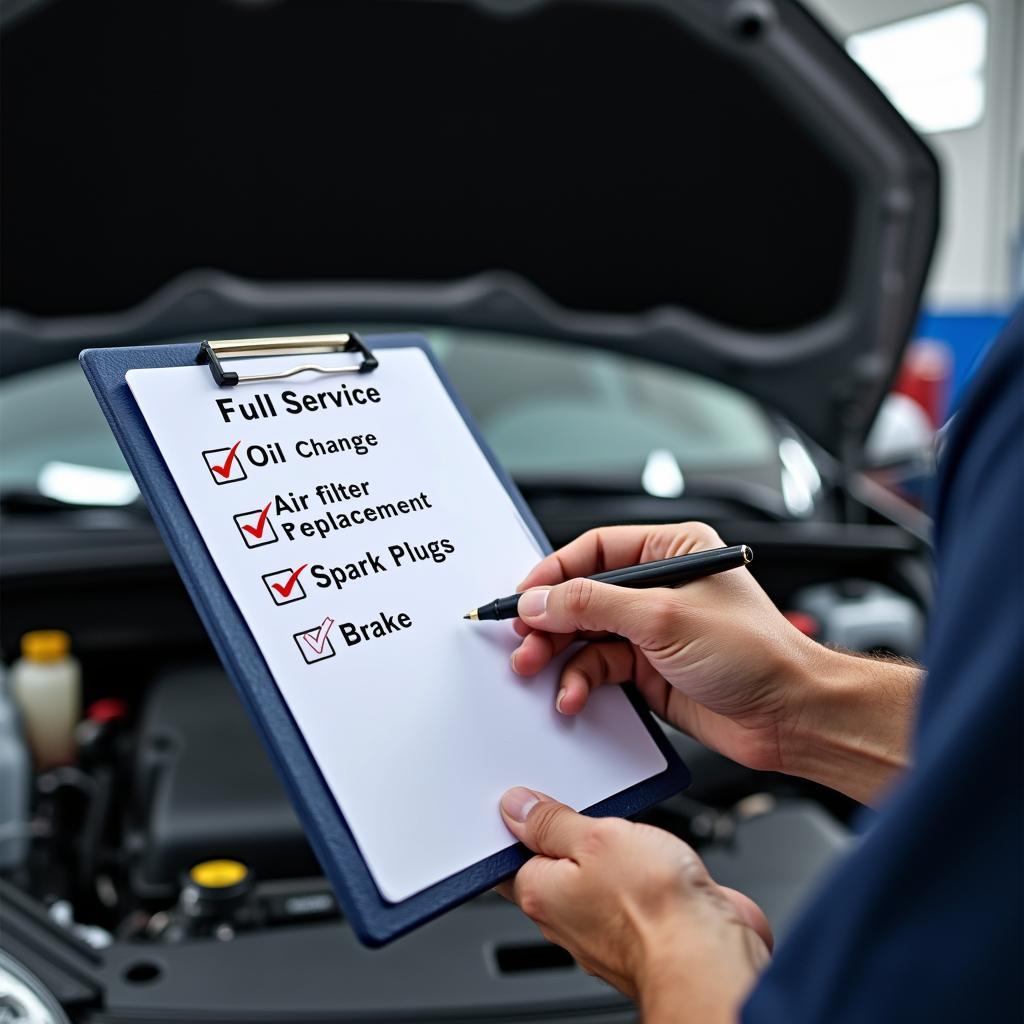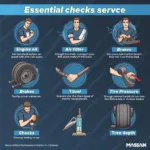A full car service is essential for maintaining its performance, reliability, and safety. Knowing how to perform a full service yourself can save you money and give you a deeper understanding of your vehicle’s health. This guide will provide a comprehensive walkthrough on How To Do A Full Service On Your Car, covering everything from basic checks to more advanced procedures.
Looking for advice on the best time for a service? Check out when to service your car.
What Does a Full Car Service Entail?
A full car service is more comprehensive than a basic service. It involves a thorough inspection and maintenance of various components, aiming to prevent potential problems and ensure optimal vehicle operation. This includes checking fluid levels, replacing filters, inspecting brakes, and more. It’s an investment in the longevity and safety of your car. If you’re considering a full service, understanding what’s involved is crucial.
Essential Checks and Replacements During a Full Service
- Engine Oil and Filter Change: This is fundamental to lubricating the engine and removing contaminants. Old oil loses its viscosity and can lead to increased engine wear.
- Air Filter Replacement: A clean air filter ensures efficient airflow to the engine, optimizing combustion and fuel economy.
- Spark Plug Replacement: Worn spark plugs can cause misfires, reduced power, and decreased fuel efficiency.
- Fuel Filter Replacement: A clogged fuel filter can restrict fuel flow, leading to performance issues.
- Coolant System Check: Ensuring the coolant is at the correct level and concentration prevents overheating.
- Brake Inspection: Checking brake pads, rotors, and fluid levels is crucial for safety.
- Tire Pressure and Condition Check: Properly inflated tires with sufficient tread depth are essential for safe handling and fuel efficiency.
- Steering and Suspension Check: Inspecting these systems ensures proper alignment and handling.
- Battery Check: Checking the battery’s voltage and terminals ensures reliable starting.
- Lights and Electrical System Check: Verifying all lights and electrical components are functioning correctly enhances safety.
Knowing what are necessary things required for car servicing can make a big difference in the outcome.
Step-by-Step Guide on How to Do a Full Service on Your Car
- Gather Your Tools and Materials: Before you begin, assemble all the necessary tools, replacement parts, and fluids specific to your car model.
- Consult Your Owner’s Manual: Your owner’s manual provides specific instructions and recommendations for your vehicle.
- Safety First: Work in a well-ventilated area and wear appropriate safety gear.
- Drain the Engine Oil: Locate the oil drain plug and carefully drain the old oil into a container.
- Replace the Oil Filter: Remove the old oil filter and install a new one, lubricating the gasket before tightening.
- Refill with Fresh Oil: Add the recommended amount and type of oil for your vehicle.
- Replace the Air Filter: Locate the air filter housing and replace the old filter with a new one.
Thinking of servicing your car at home? Explore the possibilities with can car service be done at home in bhilai.
- Replace Spark Plugs: Remove the old spark plugs and install new ones, gapping them correctly.
- Replace the Fuel Filter: Locate the fuel filter and follow the proper procedure for replacing it, taking necessary precautions to avoid fuel leaks.
- Check and Top Up Fluids: Check the coolant, brake fluid, power steering fluid, and windshield washer fluid, topping them up as needed.
- Inspect the Brakes: Check the brake pads for wear and tear, and inspect the rotors for any damage.
- Check Tire Pressure and Condition: Inflate tires to the recommended pressure and check the tread depth.
- Inspect Steering and Suspension: Check for any signs of wear or damage in the steering and suspension components.
- Check the Battery: Clean the battery terminals and check the voltage.
Considering car buying services? Find out if are car buying services a good deal.
- Check Lights and Electrical System: Ensure all lights and electrical components are working correctly.
Conclusion
Performing a full car service yourself requires some mechanical knowledge and the right tools. While it can be rewarding, if you’re unsure about any aspect, it’s always best to consult a qualified mechanic. Regular maintenance is key to a long and healthy life for your car, and understanding how to do a full service on your car empowers you to take control of your vehicle’s well-being.
Are autonomous car services a reality in the US? Learn more about is autonomous car service available in the us.
FAQ
- How often should I do a full car service? Typically, a full service is recommended every 12,000 miles or annually, whichever comes first.
- What are the benefits of a full car service? A full service helps maintain your car’s performance, reliability, and safety, potentially preventing costly repairs down the line.
- Can I do a full service myself? Yes, with the right tools, knowledge, and by following the instructions in your owner’s manual.
- What if I don’t feel comfortable doing a full service myself? It’s always best to consult a qualified mechanic if you’re unsure about any aspect of car maintenance.
- How much does a full car service typically cost? The cost varies depending on your car model and the service center, but it’s generally more expensive than a basic service.
- What is the difference between a full service and a basic service? A full service is more comprehensive than a basic service, involving a more thorough inspection and maintenance of various components.
- What should I do if I notice any unusual noises or performance issues after a service? Contact your mechanic immediately to address any concerns.
Need support? Contact us via WhatsApp: +1(641)206-8880, or Email: [email protected]. Our customer service team is available 24/7.


